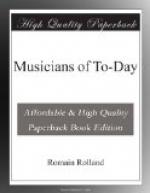But it is quite another affair with the Opera-Comique. This theatre has taken a very active part in the development of modern music. Without renouncing its classic traditions, or its delightful repertory of the old opera-comiques, it has had understanding enough, under the judicious management of M. Albert Carre, to hold itself open for any interesting productions in dramatic music. It takes no side among the different schools; and the representatives of the old-fashioned light opera with their songs elbow the leaders of the advanced school. No association has done more important work, among musical dramas as well as musical comedies, during the last twenty years. In this theatre, which produced Carmen in 1875, Manon in 1884, and the Roi d’Ys in 1888, were played the principal dramas of M. Bruneau, as well as M. Charpentier’s Louise, M. Debussy’s Pelleas et Melisande, and M. Dukas’s Ariane et Barbebleue. It may seem astonishing that such works should have found a place at the Opera-Comique and not at the Opera. But if two musical theatres of different kinds exist, one of which pretends to have the monopoly of great art, while the other with a simpler and more intimate character seeks only to please, it is always the latter that has a better chance of development and of making new discoveries; for the first is oppressed by traditions that become ever stiffer and more pedantic, while the other with its simplicity and lack of pretension is able to accommodate itself to any manner of life. How many artists have revolutionised their times while they were merely looked upon as people who amused! Frescobaldi and Philipp Emanuel Bach brought fresh life to art, but were scorned by the so-called representatives of fine art; Mozart’s opere buffe have more of truth and life in them than his opere serie; and there is as much dramatic power in an opera-comique like Carmen as in all the repertory of grand Opera to-day. And so the Opera-Comique theatre has become the home of the boldest experiments in musical drama. The most daring or the most violent ventures into musical realism, after the manner of Charpentier or Bruneau, and the subtle fantasies of a delicate art of dreams, like that of Debussy, have found a welcome there. It has also been open to various kinds of foreign art: Humperdinck’s Haensel und Gretel, Verdi’s Falstaff, the works of Puccini, Mascagni, and the young Italian school, Richard Strauss’s Feuersnot, Rimsky-Korsakow’s Snegourotchka, have all been played. And they have even given the classic masterpieces of opera there: Fidelio, Orfeo, Alceste, the two Iphigenies; and taken more pains with them and mounted them with more pious zeal than they do at the Opera. The operas themselves are more at home there, too, for the size of the theatre is more like that of the eighteenth-century theatres. It is true that the stage rather lacks depth; but




